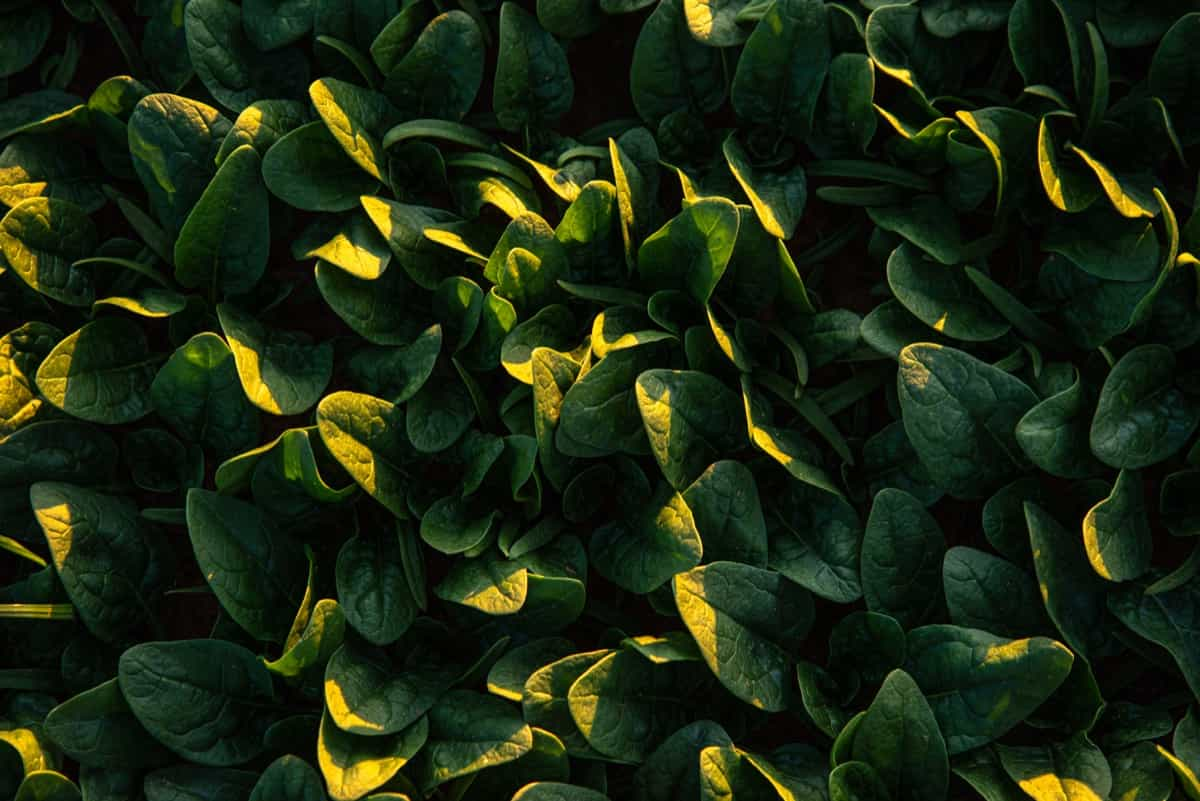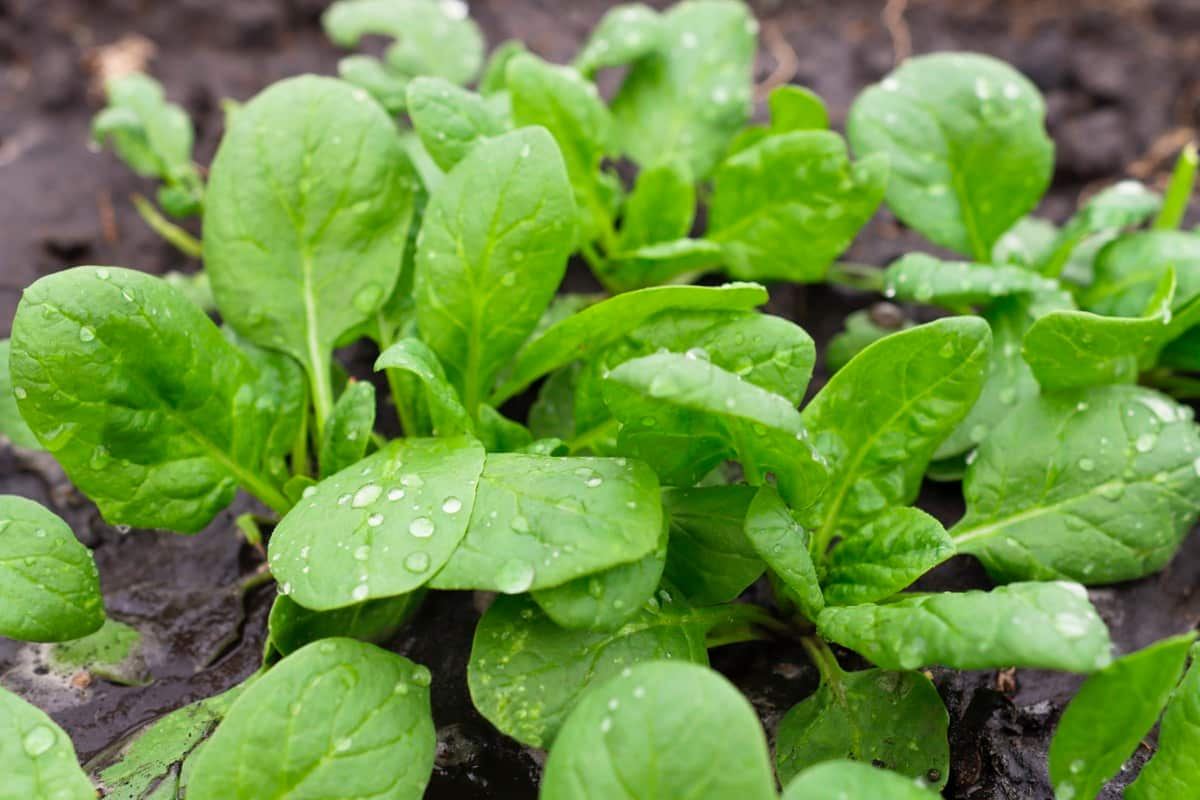Cutworms are a common pest in vegetables and can cause significant damage to crops, including spinach. These larvae of several moth species can feed on the base of spinach seedlings, causing them to wilt and die. While there are chemical pesticides available to control cutworms, there are also several non-toxic preventive measures that Farmers can take to reduce their populations. This article will discuss some practices for preventing cutworm damage in spinach fields.

Management of Cutworms in Spinach
The Life Cycle of Cutworm
- Egg: The female cutworm moth lays 1200 to 1900 eggs in clusters on foliage. The eggs are initially white but turn brown with age. The egg period lasts for 3-6 days.
- Larva: The larvae hatch from the eggs and go through five to nine instars, with six to seven instars being the most common. The larvae are smooth, cylindrical, and about two inches long when fully grown. They are known for curling into a tight “C” shape when disturbed. The larval stage can last for several weeks to months.
- Pupa: At a depth of 3 to 12 cm, the larvae finally pupate underground. The dark brown pupa is 5 to 6 mm in diameter and 17 to 22 mm in length. There are 12 to 20 days in the pupal stage.
- Adult: The cutworm moth’s wingspan ranges from 40 to 55 mm, making it a pretty sizable insect. The forewing is generally dark brown, with a short black dash running distally from the bean-shaped wing spot and a lighter irregular band in the distal region. The veins on the pale to greyish hind wings have darker scales. The moths will lay their eggs on decomposing plant matter in the absence of low-growing broadleaf plants. The soil is an unfavorable place for oviposition.
Identification of Cutworm in Spinach field
Cutworms are a common pest in spinach fields, and their identification can help determine the appropriate control measures to manage them. The general characteristics of cutworms include their smooth, hairless bodies and tendency to curl into a tight ‘C’ shape when disturbed. However, different species of cutworms may have different colors and markings, making their identification essential.
Damage Symptoms of Cutworm in Spinach Field
- Stems Cut at Soil Level: Cutworms wrap their bodies around the plant’s stem and feed on it, cutting it off just above the soil surface. This feeding behavior can cause young plants to die or slow their growth, leading to reduced yields.
- Damage to Young Plants: New transplants or young plants are more susceptible to cutworm damage because their stems are more tender. Cutworms attack new plants nightly, causing severe damage in the early season when plants are small and have tender tissue.
- Feeding on Leaves and Fruit: Some cutworm species, such as the variegated cutworm, can climb the stem of trees, shrubs, vines, and garden plants and eat the leaves, buds, and fruit.
- Underground Feeding: Some species, such as the glassy cutworm, remain in the soil and feed upon roots and underground parts of the plant.
- Nocturnal Feeding: Cutworms feed in the evening or night and hide in plant debris during the day. This feeding behavior can make their detection challenging.
Management of Cutworm in Spinach by Cultural Method
- Weed control: weeds like lambsquarters and wild mustard can attract egg-laying females and provide food for larvae. Therefore, controlling weeds in and around the spinach field can help reduce the risk of cutworm infestation.
- Fall tillage: Fall tillage can help destroy overwintering pupae. This involves tilling the soil in the fall after harvest to expose the pupae to cold temperatures, which can kill them.
- Debris removal: Removing debris in the vegetable garden that provides cover for cutworms can help reduce their populations. This includes removing plant debris and any other objects that can provide shelter.
In case you missed it: Yellow Leaf Disease Management in Sugarcane: Symptoms, Identification, Treatment, Chemical, Biological, Natural, and Organic Control

Management of Cutworm in Spinach by Biological Method
- Pyrethrins: These are natural insecticides derived from chrysanthemum flowers. Some formulations are OMRI-listed for organic use and can be effective against cutworms.
- Spinosad: This is a natural insecticide derived from soil bacteria. It is highly effective against cutworms and other pests, and some formulations are OMRI-listed for organic use.
Management of Cutworm in Spinach by Chemical Method
- Bifenthrin/imidacloprid (Brigadier): This product can be applied at a rate of 0.08 to 0.096 lb ai/A and has a PHI of 40 days. The maximum application rate per season is 0.24 lb ai/A for both bifenthrin and imidacloprid. The retreatment interval is 7 days.
- Borate complex: This OMRI-listed product can be applied as a 0.4% solution for complete coverage. It has a REI of 12 hr.
- Burkholderia spp: This OMRI-listed product can be applied at 1 to 4 quarts/A. It has a PHI of 0 days and an REI of 4 hr.
- Carbaryl: This product can be applied at 1 to 2 lb ai/A with a PHI of 14 days. The maximum application rate per season is 6 lb ai/A, and the retreatment interval is 7 days. Limit five treatments per year.
Management of Cutworm in Spinach by Organic/Natural Method
- Kaolin: This natural clay-based product can be applied as a spray to foliage. It acts as a repellent to some insect pests, including cutworms. Some formulations are OMRI-listed for organic use.
- Permethrin is a synthetic insecticide derived from a natural compound called pyrethrum. It is highly effective against cutworms and can be used in organic farming if derived from a natural source.
- Plant essential oils: Some plant essential oils, such as rosemary, have demonstrated efficacy against lepidopteran larvae, including cutworms. Some formulations are OMRI-listed for organic use.
Preventive Measures for Control of Cutworm in Spinach Field
- Clean up the spinach field by removing weeds and plant debris before planting.
- Till the soil after fall is cleaned up to expose any cutworm larvae and pupae, which birds and other predators can pick off.
- Mow as closely as possible to the edge of the spinach field to reduce food and shelter for cutworms near the plants.
- Create a bare soil strip at least three feet wide between the lawn and spinach field to make it harder for cutworm larvae to reach the plants.
- Delay planting spinach starts as long as possible to allow cutworms to starve before putting out new food.
- Use cardboard collars or milk containers with the bottom cut out to protect transplant stems from cutworm damage.
- Consider planting a border of sunflowers around the spinach field to attract cutworms away from the crop and make it easier to pick them off.
In case you missed it: Management of Leaf Miner in Spinach: Symptoms, Treatment, Chemical, Biological, Natural and Organic Control

Conclusion
Preventing cutworm damage in spinach fields is essential for healthy crop growth and maximum yield. While chemical pesticides can be effective, they are only sometimes desirable or necessary. Farmers can significantly reduce cutworm populations and protect their spinach crops by taking simple preventive measures such as removing plant debris, creating bare-soil strips, and using cardboard collars around transplant stems. Following these best practices, farmers can enjoy a bountiful harvest of fresh and healthy spinach.
- Beneficial Insects in Pest Management
- Natural Solutions for Pest Control in Flower Gardens
- Types of Fungicides Used in Agriculture
- Common Issues in the Fruit Development Stage of Pomegranate Farming
- Fruit Development Issues in Papaya: Easy Solutions and Treatment
- Soil-Borne Diseases and How to Protect Your Plants
- Practices to Prevent Disease Spread in the Garden
- From Wilted to Thriving: How to Treat Root Rot Naturally in Houseplants
- Natural Remedies to Cure Brown Spots on Fig Tree Leaves